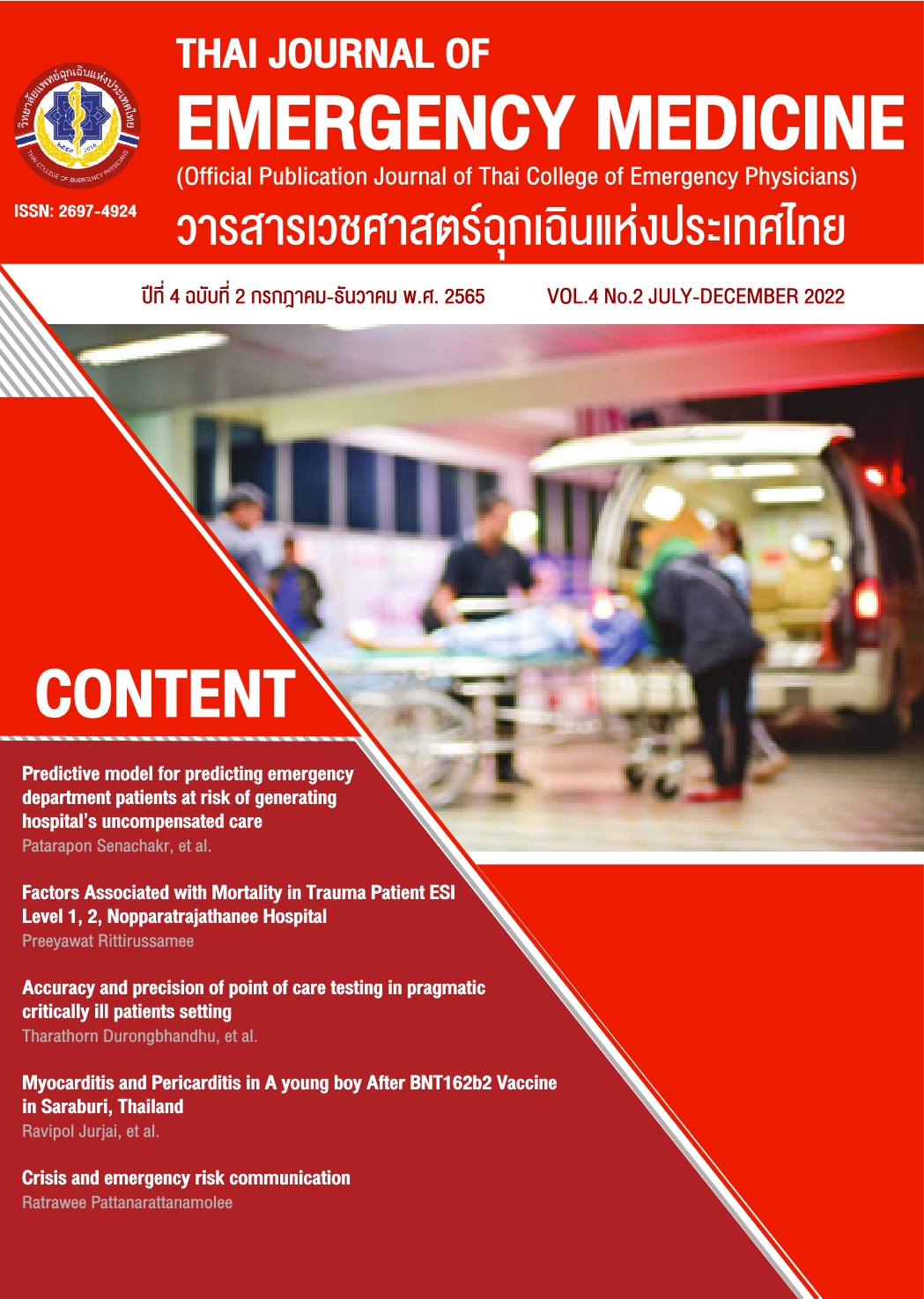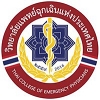Crisis and emergency risk communication
Keywords:
emergency risk communication, disasterAbstract
Communication regarding disaster risk and messages during a disaster is a vital process for success in disaster management. The message designer has to understand how people receive and interpret the message. This comprehension would make the designer produce an understandable message that will affect the action against disaster. Emergency Risk Communication can be used before, during, and after a disaster to make recommendations on how to prepare for, respond to, and recover from disaster. Currently, the methods for communication are various, such as radio, television (TV), and social media, which would be selected and controlled for the full benefit of the situation. Social media is now widely used, convenient, practical, and serves as a boarding connection. However, rumor is one of the disadvantages, which may result in confusion and a chaotic situation in disaster. Besides, multiple methods of communication are needed during disaster because of the different capacities for accessing the message depending on the culture and popularity of each recipient group. For example, while teenagers would prefer social media, older people may be prefer radio and TV. In addition, the local language message would make the message simpler to understandable.
References
Blanchard BW, Canton LG, Cwiak CL, et al. Principles of Emergency Management Supplement. Published online October 1, 2007. doi:10.13140/RG.2.2.32021.93925
Jin D, Lin J. Managing tsunamis through early warning systems: A multidisciplinary approach. Ocean Coast Manag. 2011;54(2):189- 199. doi:10.1016/j.ocecoaman.2010.10.025
Leaning J, Guha-Sapir D. Natural disasters, armed conflict, and public health. N Engl J Med. 2013;369(19):1836-1842. doi:10.1056/NEJMra1109877
Gaillard JC. Vulnerability, capacity and resilience: Perspectives for climate and development policy. J Int Dev. 2010;22(2): 218-232. doi:10.1002/jid.1675
Howard A, Agllias K, Bevis M, Blakemore T. “They’ll tell us when to evacuate”: The experiences and expectations of disasterrelated communication in vulnerable groups. Int J Disaster Risk Reduct. 2017;22:139-146. doi:10.1016/j.ijdrr.2017.03.002
Palttala P, Boano C, Lund R, Vos M. Communication gaps in disaster management: perceptions by experts from governmental and non-governmental organizations. J Contingencies Crisis Manag. 2012;20(1):2-12. doi:10.1111/j.1468-5973.2011.00656.x
Khan S, Mishra J, Lin K, H Doyle E. Rethinking communication in risk interpretation and action. Nat Hazards. 2017;88:1-18. doi:10.1007/s11069-017-2942-z
World Health Organization, ed. Communicating Risk in Public Health Emergencies: A WHO Guideline for Emergency Risk Communication (ERC) Policy and Practice. World Health Organization; 2017.
Reynolds B, W Seeger M. Crisis and emergency risk communication as an integrative model. J Health Commun. 2005;10(1):43-55. doi:10.1080/10810730590904571
Edwards A. Communicating risks. BMJ. 2003;327(7417):691-692.
Khan S. Living in a Hazardscape: A Study of Hazards and Response in the Wellington Region, New Zealand. LAP LAMBERT Academic Publishing; 2012.
Morgan MG, Fischhoff B, Bostrom A, Atman CJ. Risk Communication: A Mental Models Approach. Cambridge University Press; 2002.
Infanti J, Sixsmith J, Barry M, Núñez-Córdoba J, Oroviogoicoechea-Ortega C, Guillén-Grima F. A Literature Review on Effective Risk Communication for the Prevention and Control of Communicable Diseases in Europe. ECDC; 2013. Accessed April 30, 2019. http://ecdc.europa.eu/en/publications-data/literature-review-effective-risk-communication-prevention-and-control
Hanson-Easey S, Every D, Hansen A, Bi P. Risk communication for new and emerging communities: The contingent role of social capital. Int J Disaster Risk Reduct. Published online January 17, 2018. doi:10.1016/j.ijdrr.2018.01.012
Scolobig A, Prior T, Schröter D, Jörin J, Patt A. Towards people-centred approaches for effective disaster risk management: balancing rhetoric with reality. Int J Disaster Risk Reduct. 2015;12:202-212. doi:10.1016/j.ijdrr.2015.01.006
Kasperson R. Four questions for risk communication. J Risk Res. 2014;17(10):1233-1239. doi:10.1080/13669877.2014.900207
Eisenman DP, Cordasco KM, Asch S, Golden JF, Glik D. Disaster Planning and Risk Communication With Vulnerable Communities: Lessons From Hurricane Katrina. Am J Public Health. 2007;97(Suppl 1):S109-S115. doi:10.2105/AJPH.2005.084335
Phibbs S, Kenney C, Solomon M. Ngā Mōwaho: an analysis of Māori responses to the Christchurch earthquakes. Kōtuitui N Z J Soc Sci Online. 2015;10(2):72-82. doi:10.10 80/1177083X.2015.1066401
New Zealand immigration. The Treaty of Waitangi | New Zealand Now. Published November 28, 2018. Accessed May 5, 2019. https://www.newzealandnow.govt.nz/living-in-nz/history-government/the-treatyof-waitangi
IPCC. Climate Change 2014: Synthesis Report. The intergovernmental panel on climate change; 2014. https://www.ipcc.ch/site/assets/uploads/2018/02/AR5_SYR_FINAL_SPM.pdf
Downloads
Published
How to Cite
License
Copyright (c) 2023 Thai Collage of Emergency Physicians

This work is licensed under a Creative Commons Attribution-NonCommercial-NoDerivatives 4.0 International License.
บทความที่ได้รับตีพิมพ์ในวารสารเวชศาสตร์ฉุกเฉินแห่งประเทศไทย ถือเป็นเป็นลิขสิทธิ์ของ วิทยาลัยแพทย์เวชศาสตร์ฉุกเฉินแห่งประเทศไทย
กรณีที่บทความได้รับการตีพิมพ์ในวารสารเวชศาสตร์ฉุกเฉินแห่งประเทศไทยแล้ว จะตีพิมพ์ในรูปแบบอิเล็กทรอนิกส์ ไม่มีสำเนาการพิมพ์ภายหลังหนังสือเผยแพร่เรียบร้อยแล้ว ผู้นิพนธ์ไม่สามารถนำบทความดังกล่าวไปนำเสนอหรือตีพิมพ์ในรูปแบบใดๆ ที่อื่นได้ หากมิได้รับคำอนุญาตจากวารสารเวชศาสตร์ฉุกเฉินแห่งประเทศไทย




